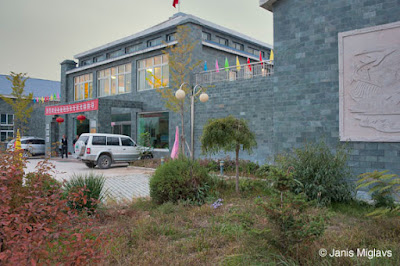 |
| Two women chatting in the Bedik village of Iwol, Senegal, Africa. |
It’s
time to leave. After more than a week of camping in the remote Puel village of Ibel, I’m
hiking out towards the road, the car and the beginning of my journey home.
Thoughts and emotions wash over me as I reflect on all that I have experienced in this village and the neighboring Bedik tribe.
 |
| This is the Puel tribe village of Ibel, where I stayed for more than a week while visiting the neighboring Bedik tribe, Senegal, Africa. |
My translator/guide
Pacoo and my host Omar Ba walk in the lead with a tail of kids laughing and following behind
me. Totally absorbed in my thoughts, suddenly I hear
a woman’s voice. At the entrance of her
family compound she saying something loud enough for us to hear. And she’s
pointing her head towards me.
Janis: “Pacoo,
what did she say?”
Pacoo
replies: “She say, it looks as if not all whites are bad.”
Wow. I teared up. At first I felt honored, special. Was that a sign of acceptance?
But as
I continued to trudge along the grassy path, wave after wave of thoughts washed
over my mind.
What
made this grandmother-aged woman in this remote pocket of Senegal first classify
whites as bad? It was us versus whites, us versus them?
I even thought, oh what a cruel hoax God played on us by painting humans different colors. Was it
a test to teach us lessons?
 |
| Here I am surrounded by Konso tribe women in Ethiopia, Africa. |
And what had I done to change her mind about whites? Was it playing with the kids
each morning, taking notes as elders talked, instigating a meeting of chiefs to
talk about how tourism could bring money to pay their taxes or …?
Traveling
by myself, I think a lot about the importance of belonging to something bigger than myself. The woman belongs to a tribe, kids belong to gangs,
the Tambacounda shopkeeper who kicked me out because I wasn't Muslim belongs to a religion and I’m headed home to my
family and my tribes. But the older woman’s
casual statement reveals a great divide between groups she has delineated, whites
and her tribe.
How
does this happen? The little children who greeted me each morning were curious,
totally accepting. What changes these children? Is it our human craving to belong?
 |
| This photograph of Konso children at the gate is a symbol of my hope for the future. Konso tribe, Ethiopia, Africa. |
And what is the secret to dissolving the calcified barriers we
build as we age in place?
All photographs and text © 2015 Janis Miglavs
www.jmiglavs.com
janis@jmiglavs.com

















































